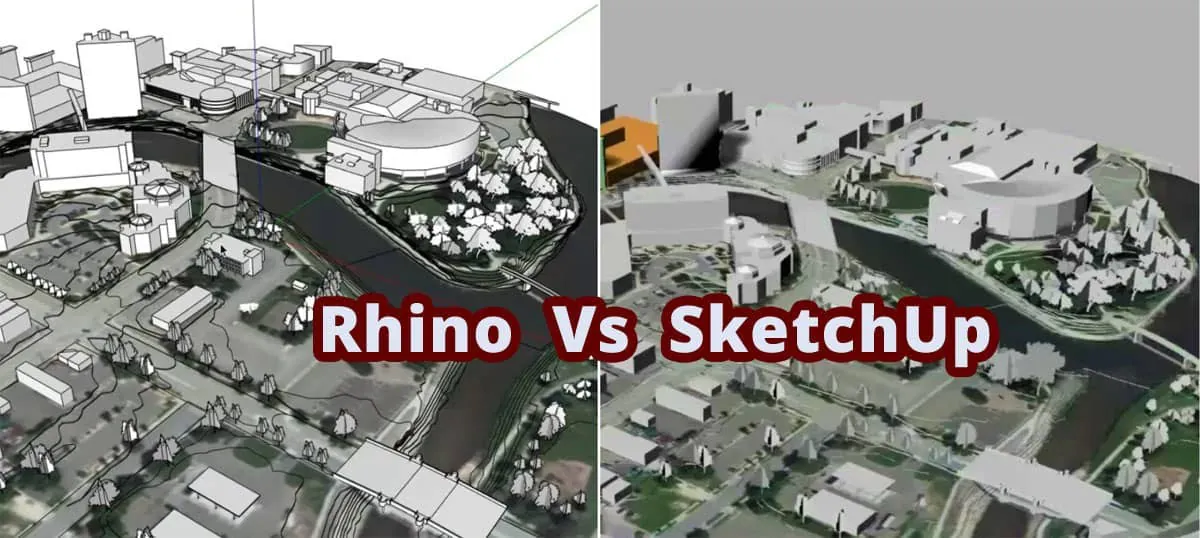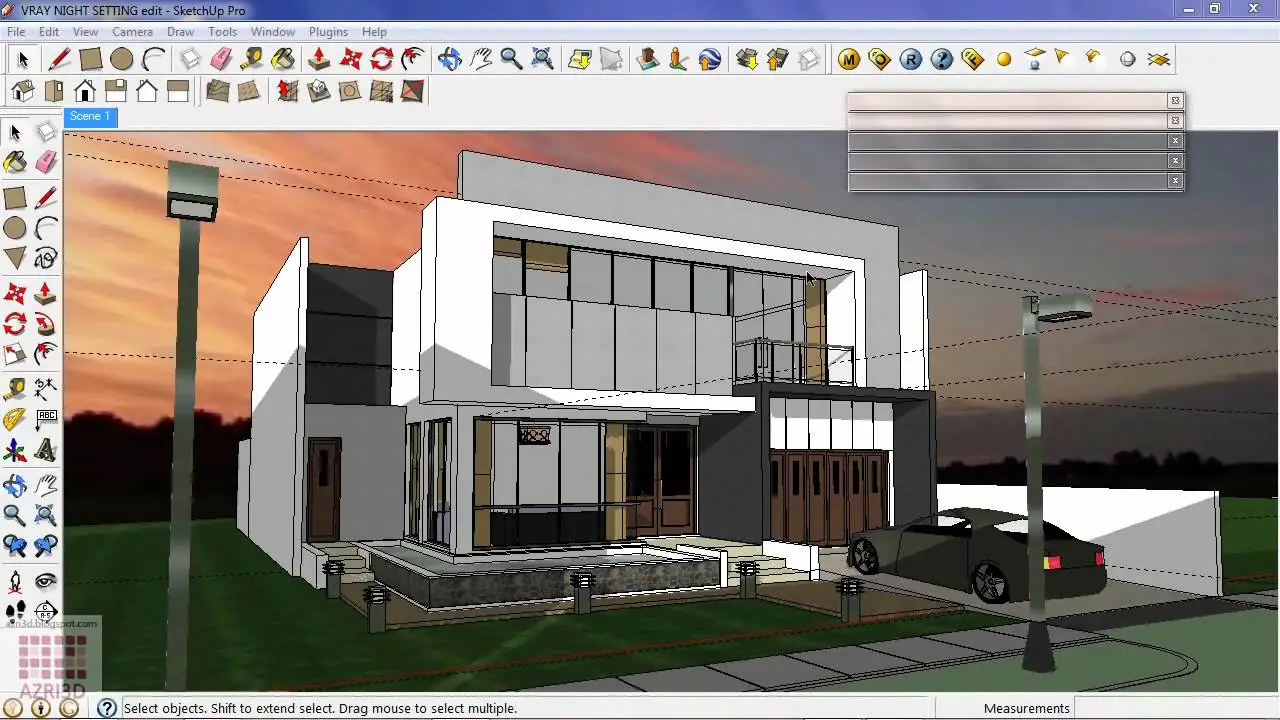
Rhino Vs SketchUp
Rhino and SketchUp are two popular software tools designers and architects use for 3D modelling and design. While both programs have unique features and capabilities, they are designed for different purposes and have different strengths and weaknesses. Rhino, also known as Rhinoceros, is a powerful 3D modelling software commonly used in automotive design, product design, and architecture. It is known for its precise modelling tools, high-quality rendering capabilities, and ability to handle complex geometries. SketchUp, on the other hand, is a more user-friendly and accessible 3D modelling software often used by architects, interior designers, and hobbyists. It is acknowledged for its ease of use, intuitive interface, and ability to create basic 3D models quickly. In this essay, we will explore the differences between Rhino and SketchUp, their unique features, and the pros and cons of each software. We will also examine some use cases where one software may be more suitable and provide recommendations for which software may best suit different design needs.
The Key Differences between Rhino and SketchUp and Their Unique Features:
Rhino and SketchUp are two widely used 3D modelling software with unique features and capabilities. Here are some of the major differences between Rhino and SketchUp:
User Interface:
SketchUp has a more intuitive user interface compared to Rhino. It is designed to be user-friendly, with tools and commands that are easy to access and understand. On the other hand, Rhino has a steeper learning curve, with a more complex user interface that requires some time to get used to.
Precision:
Rhino is known for its precision modelling tools that can handle complex geometries with accuracy and precision. It has many tools and features allow designers to create precise 3D models for manufacturing and engineering purposes. SketchUp is more suitable for creating basic 3D models with less precision.
Rendering:
Rhino has advanced rendering capabilities, with the ability to create high-quality photorealistic images and animations. It has a wide range of rendering plugins that can enhance the visual quality of the models. SketchUp has basic rendering capabilities, creating simple 3D models with basic textures and materials.
File Compatibility:
Rhino supports various file formats, including DWG, DXF, STEP, and IGES. It is also compatible with many other 3D modelling software such as AutoCAD and Revit. SketchUp has limited file compatibility and can import and export only a few file formats, such as OBJ, 3DS, and SKP.
Price:
Rhino is a more expensive software compared to SketchUp. Rhino 3D costs around $995 for a single-user license, while SketchUp Pro costs around $299 per year for a subscription license.
Rhino is more suitable for complex 3D modelling tasks requiring precision and accuracy, while SketchUp is more suitable for creating basic 3D models with an intuitive interface. The choice between the two software ultimately depends on the design requirements, level of expertise, and user budget.
Use cases of Rhino and SketchUp:
Rhino and SketchUp are popular 3D modelling software with different use cases and strengths. Here are some examples of when Rhino is the better choice and when SketchUp is the better choice:
Use Cases of Rhino
Architecture:
Rhino is commonly used in architecture to create precise 3D models of building components such as facades, roofs, and windows. It also produces 2D construction documents, 3D visualization, and animation. Rhino’s accuracy and precision make it ideal for architectural projects that require a high level of detail.
Industrial Design:
Rhino is a popular choice among industrial designers for creating precise 3D models of products and prototypes. It is used for designing everything from toys to cars to appliances. Rhino’s flexibility and ability to work with various file formats make it a powerful tool for industrial design.
Product Design:
Rhino is also used extensively in the product design industry for creating precise 3D models of products. It is used for designing everything from consumer electronics to furniture to medical devices. Rhino’s accuracy and precision make it ideal for product design projects that require a high level of detail.
Jewellery Design:
Rhino is a popular choice among jewellery designers for creating precise 3D models of jewellery pieces. It is used for designing everything from rings to necklaces to bracelets. Rhino’s accuracy and precision make it ideal for jewellery design projects that require a high level of detail.
Film and Entertainment:
Rhino is also used in the film and entertainment industry for creating 3D models of characters, props, and environments. It is used for creating everything from animated movies to special effects for live-action films. Rhino’s flexibility and ability to work with various file formats make it a powerful tool for film and entertainment.
Recommendations for Rhino:
While Rhino is a powerful tool for creating precise and accurate 3D models, some may have better options. Here are some recommendations for when Rhino is the best choice:
Precision and Accuracy: Rhino is recommended for users who require precision and accuracy in their 3D modelling tasks. It is best suited for users with experience in CAD software and those who need to create detailed 3D models for manufacturing or engineering purposes.
Complex Geometries: Rhino is also recommended for users who need to create complex geometries that cannot be easily created with other 3D modelling software. Its flexibility and ability to work with various file formats make it a powerful tool for creating complex shapes and forms.
Multiple Outputs: Rhino is recommended for users who must produce multiple outputs from their 3D models. It is used for producing 2D construction documents, 3D visualization, and animation, making it a versatile tool for a wide range of design tasks.
Integration with Other Software: Rhino is recommended for users who must integrate their 3D models with other software. It is compatible with enormous file formats, making transferring files between different software applications easy.
Budget: Rhino is recommended for users who have the budget for a more expensive 3D modelling software. Rhino is a powerful tool but comes with a higher price tag than other 3D modelling software.
Use cases of SketchUp:
SketchUp is a 3D modelling software widely used in various industries, including architecture, interior design, product design, and engineering. Here are some specific use cases of SketchUp:
Architecture: Architects often use SketchUp to create basic 3D models of buildings. It also creates site plans, interior designs, and presentation materials. SketchUp’s user-friendly interface makes it an accessible tool for architects of all skill levels.
Interior Design: SketchUp is also widely used in the interior design industry for creating 3D models of rooms and furniture. It is used for creating floor plans, designing layouts, and presenting design concepts to clients. SketchUp’s ability to quickly create 3D models makes it a popular choice among interior designers.
Product Design: SketchUp is a popular choice among product designers for creating 3D models of products and prototypes. It is used to design everything from consumer electronics to furniture and industrial equipment. SketchUp’s user-friendly interface and easy-to-learn tools make it powerful for product designers.
Engineering: SketchUp is also used in the engineering industry for creating 3D models of mechanical parts and assemblies. It is used for creating diagrams, simulations, and prototypes. SketchUp’s ability to work with various file formats makes it a versatile tool for engineers.
Education: SketchUp is also used in educational settings for teaching 3D modelling skills to students. It is used in architecture and design schools, as well as in K-12 education. SketchUp’s user-friendly interface and free online resources make it an accessible tool for students of all ages.
Recommendations for SketchUp:
SketchUp is a user-friendly 3D modelling software that is ideal for beginners and those who need to create simple 3D models. Here are some recommendations for when SketchUp is the best choice:
User-Friendly Interface: SketchUp is recommended for users who need user-friendly 3D modelling software. Its easy-to-learn tools and intuitive interface makes it accessible to users of all skill levels.
Quick 3D Modeling: SketchUp is recommended for users who need to create 3D models quickly. Its user-friendly interface and simple tools make it easy to create basic 3D models in a short amount of time.
Basic 3D Modeling: SketchUp is recommended for users who need to create simple 3D models. It is best suited for users who do not require the precision and accuracy of other 3D modelling software.
Integration with Other Software: SketchUp is recommended for users who must integrate their 3D models with other software. It is compatible with various file formats, making transferring files between software applications easy.
Budget: SketchUp is recommended for users who are on a budget. SketchUp offers a free version of its software and a more robust paid version at a lower price point than other 3D modelling software.
Conclusion:
In conclusion, when choosing between Rhino and SketchUp, it’s important to consider your specific design needs, skill level, and budget. Both Rhino and SketchUp are powerful 3D modelling software that can be used for a variety of design tasks. Rhino is the better choice for complex designs, professional designers, and 3D printing, while SketchUp is ideal for beginners, simple designs, collaborative projects, and presentation and visualization. Ultimately, both software have their strengths and weaknesses, and the best choice depends on the specific requirements of your design project.






